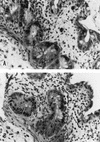Cryptosporidium parvum infection of human intestinal xenografts in SCID mice induces production of human tumor necrosis factor alpha and interleukin-8
- PMID: 9573136
- PMCID: PMC108210
- DOI: 10.1128/IAI.66.5.2379-2382.1998
Cryptosporidium parvum infection of human intestinal xenografts in SCID mice induces production of human tumor necrosis factor alpha and interleukin-8
Abstract
The protozoan parasite Cryptosporidium parvum invades intestinal epithelial cells and can cause life-threatening diarrhea in immunocompromised individuals. Despite the clinical importance of this organism, much remains to be learned about the pathogenesis of C. parvum-induced diarrhea. To explore the role of the intestinal inflammatory response in C. parvum disease, using C. parvum oocysts we infected human intestinal xenografts in severe combined immunodeficient (SCID) mice. Seven days after infection, we found levels of human tumor necrosis factor alpha and interleukin-8 in C. parvum-infected human intestinal xenografts that were significantly higher than those seen in uninfected control xenografts. These results demonstrate that human intestinal cells produce proinflammatory cytokines in response to C. parvum infection and establish SCID-HU-INT mice as a model system to study the interactions of C. parvum with the human intestine.
Figures



References
-
- Genta R M, Chappell C L, White A C, Jr, Kimball K T, Goodgame R W. Duodenal morphology and intensity of infection in AIDS-related intestinal cryptosporidiosis. Gastroenterology. 1993;105:1769–1775. - PubMed
-
- Godwin T A. Cryptosporidiosis in the acquired immunodeficiency syndrome: a study of 15 autopsy cases. Hum Pathol. 1991;22:1215–1224. - PubMed
-
- Goodgame R W, Kimball K, Ou C N, White A C, Jr, Genta R M, Lifschitz C H, Chappell C L. Intestinal function and injury in acquired immunodeficiency syndrome-related cryptosporidiosis. Gastroenterology. 1995;108:1075–1082. - PubMed
-
- Griffiths, J. K. Human cryptosporidiosis: epidemiology, transmission, clinical disease, treatment, and diagnosis. Adv. Parasitol., in press. - PubMed
Publication types
MeSH terms
Substances
Grants and funding
LinkOut - more resources
Full Text Sources
Medical

